Tell us about your project. We will get in touch shortly to discuss in more detail. You can also email us at info@sunstrikestudios.com
Tell us about your project. We will get in touch shortly to discuss in more detail. You can also email us at info@sunstrikestudios.com
Tell us about your project. We will get in touch shortly to discuss in more detail. You can also email us at info@sunstrikestudios.com
Working on composition in illustrations
Working on composition in illustrations
Hello, everyone! SunStrike Studio creates graphics for mobile and computer games. Below you will find detailed feedback on one of the tasks performed as part of our open test assignment. The author of the work has given us permission to publish this information.
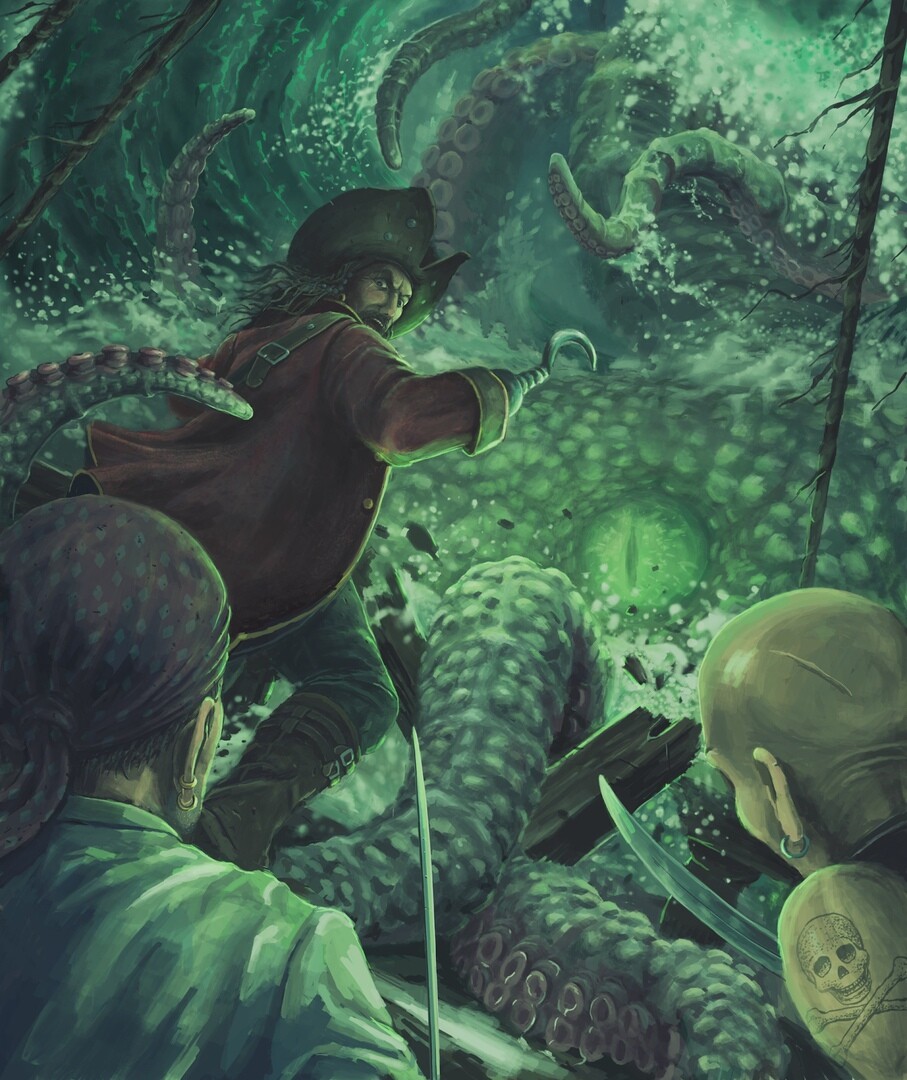
Art of the Artis tIvan Shinkevich
Tone. The main goal of the illustration is to direct the viewer’s gaze towards a specific point, the center of the composition. This includes working with tonal contrasts. If we take a look at the works of masters created with a fairly tight color pallet in black and white, we will see that the center of the composition has a focal point that uses brighter, more contrasting colors. The further away from the center of the composition, the less contrasting the tone will be.

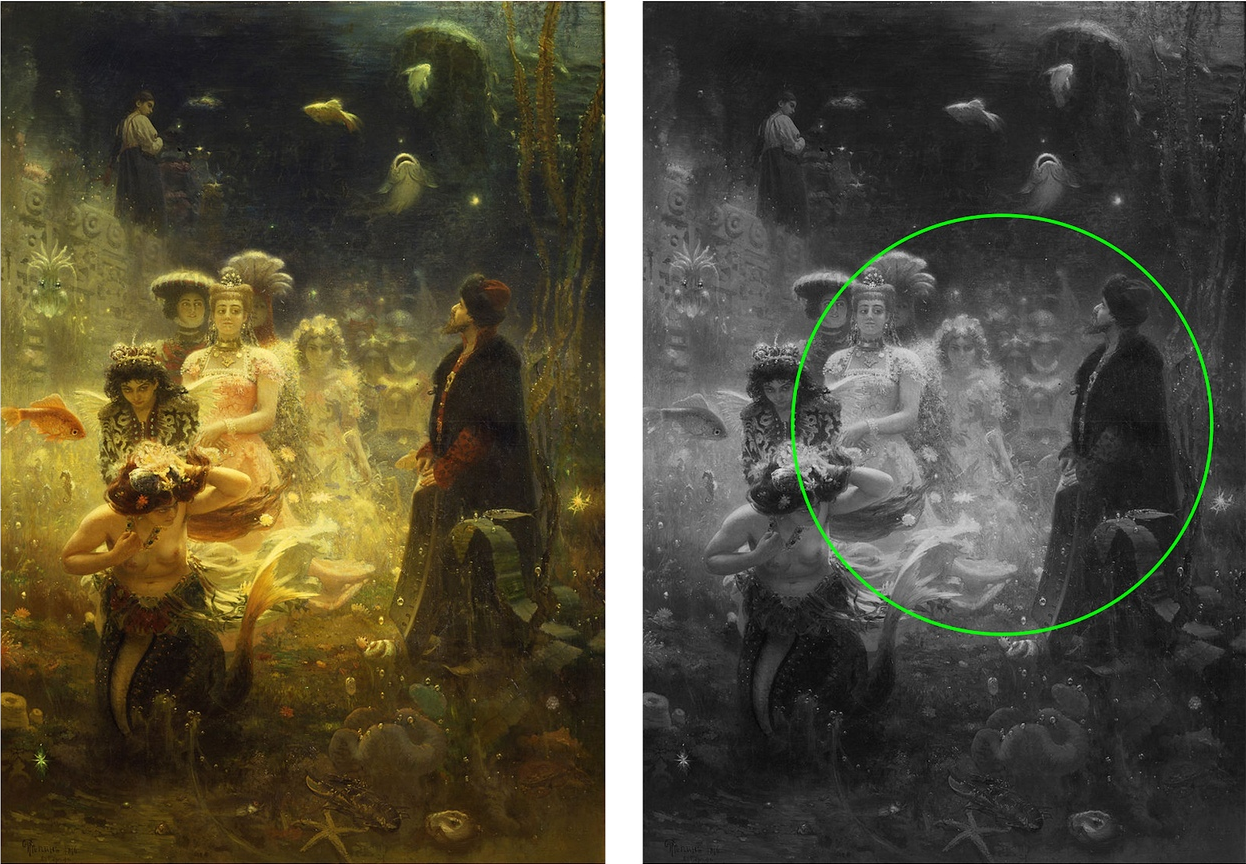
The test task illustration has all of the tones jumbled together. If you switch the picture to black and white, you will see that the composition does not have a defined center. The tonal blocks are not subdivided, which prevents the audience from focusing on the important part.
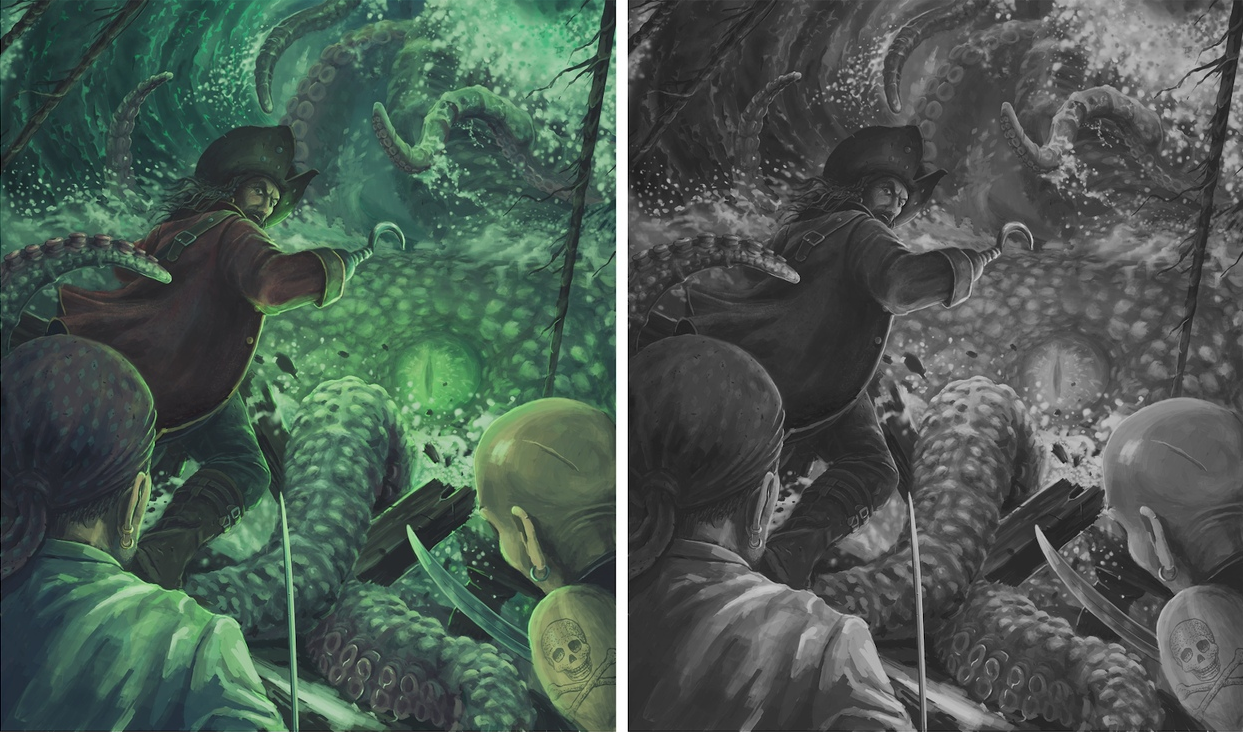
Below is an example of how you could group the sections by tone and highlight the center of the composition:
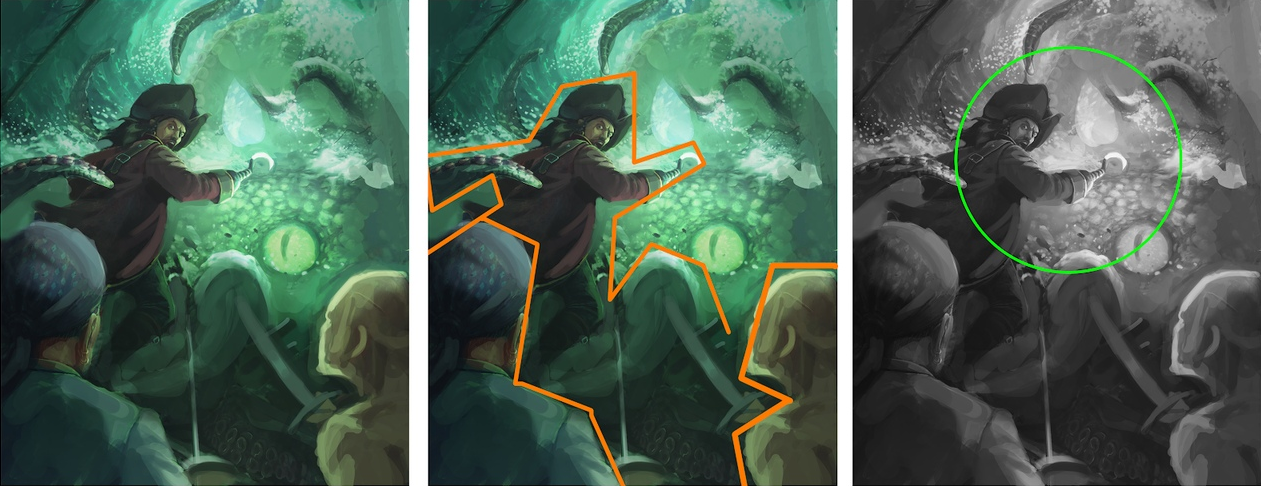

Composition. The composition is also affected by lines. They direct the viewer's gaze towards the main object in the image. Overall, this picture does a fairly good job of using guiding lines. But because of their number, and the fact that they are fragmented by tone, the audience will have a bit of trouble comprehending the image. There are too many visible tentacles. You can safely remove 2-3 of them or differentiate them by using contrast. In terms of composition, it would be better if the pirate on the right side was looking at the captain instead of his own feet. Especially since it is clear that the captain is trying to motivate his crew to fight a battle:
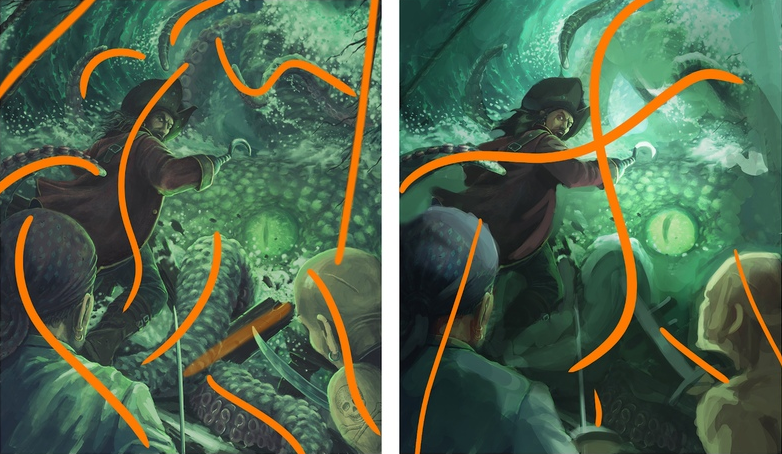

The composition usually does not work well when straight contrasting objects are “stuck” into the character (see picture on the left). It is best to avoid doing so. Also, it is not a good idea to cut off the head and the shoulder in the forefront of the image and let the sabre stick out from the body. It would work much better if more of the body was shown and the left shoulder was moved a bit further back. In this pose the right hand with the sabre would be sticking out forward. Along with the sabre, you can show a bit of the wrist:
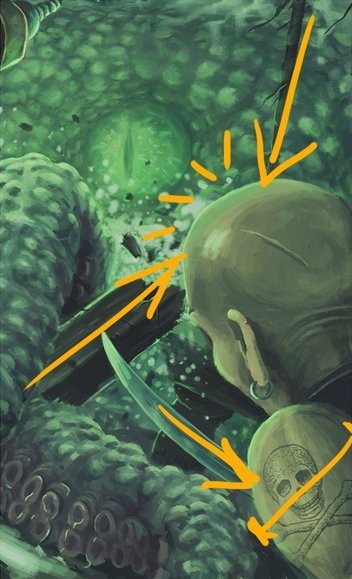
Anatomy. If the illustration uses complex angles, make sure to study the references of the figure and skull before you begin. This will help determine where the zygomatic bone should be, how the jaw will protrude, at what angle the nose will be positioned, and how the perspective will distort thirds of the face. The captains character illustrates this well - the proportions of the face are incorrect and it does not obey the perspective it is displayed in. The nose is too long, the jaw has to protrude forward. Eyebrows are curved very unnaturally. It would work much better if they were displayed a bit simpler:
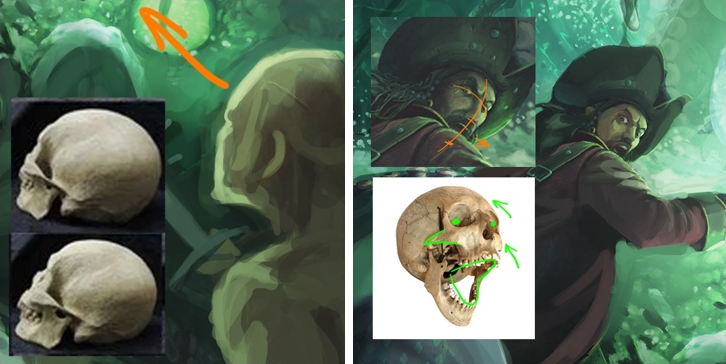

Take some time to study the facial muscles:
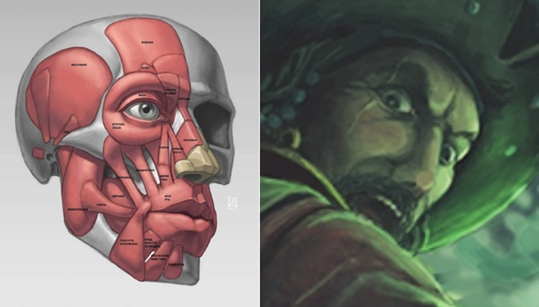
Here we can see that the nasolabial fold is very exaggerated and looks more like a large muscle, which does not actually exist. It weights down the nose of the character.
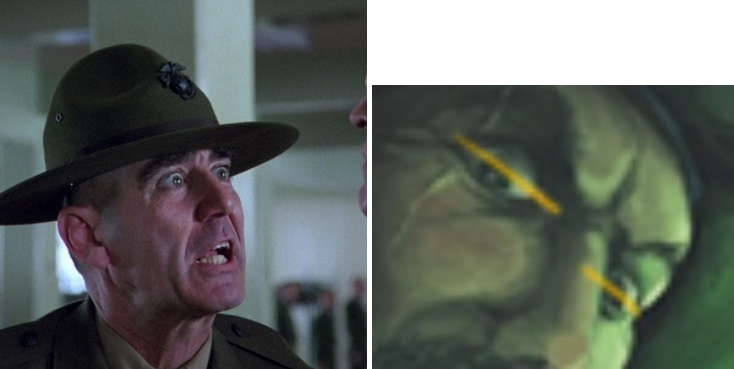
You should also make sure to check the facial features as they related to the axis line. The eyes are noticeably at different levels. The shoulder should be made a bit longer.
The pose of the pirate on the right should be made to look more dynamic. References will once again help us here. It would be best to redo the whole composition by showing more of the body and “unsticking” the head from the edge of the sheet.
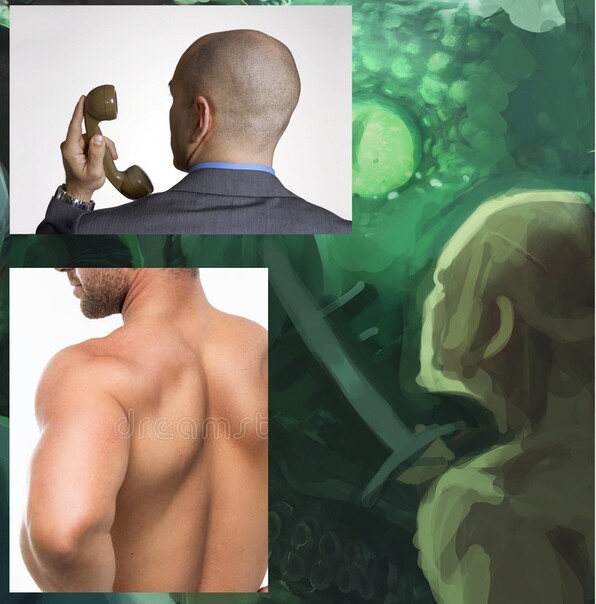
Folds. The perspective on the folds on the back of the trench coat is distorted, which makes the left side of the coat look shorter than the right one. The folds are overall too small, frequent and monotonous in their rhythm. Pay attention to this and study reference materials. The thickness of the fabric will also have an effect on how the folds look:
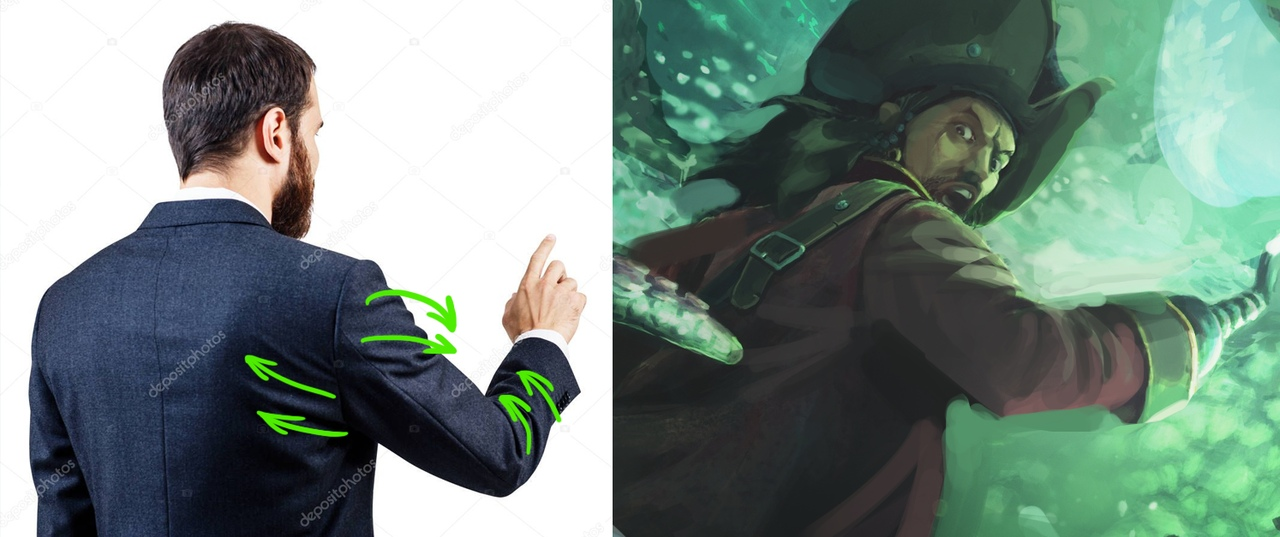
The only way the folds on the shoulders of the left pirate would look like that would be if he grabbed his shirt in the middle on the front and pulled it downward. It would work much better if they were simplified as well. The folds on the sleeve look overall good, but should be more carefully drawn, instead of using such rough brushstrokes to show volume. Taking a look at the folds and scratches on the head of the right pirate, we should keep in mind that skinfolds and scratches on the body have different properties than folds and scratches on other objects. Here too we need to study the references:
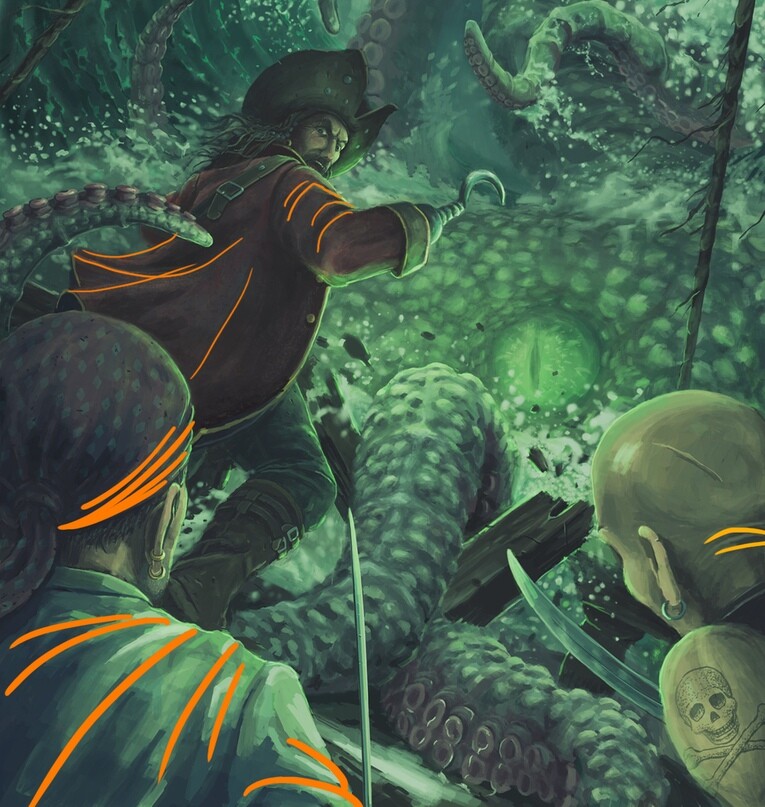
Material Render. So far, all the materials in the illustration have been drawn in the same manner using rough brushstrokes. In reality, each type of material will have its own physical properties. How do they reflect light? What creates a glare? Each material has its own texture. For example, the tentacles of the octopus will be slimy and shiny. The metal will have many contrasting reflections. Skin will have different shades in middle tones and in the shadows when illuminated with a cold light source. If the skin and hair are wet, they will reflect the sky more.
Before staring a large project you should spend some time studying the different materials and putting together a mood board:
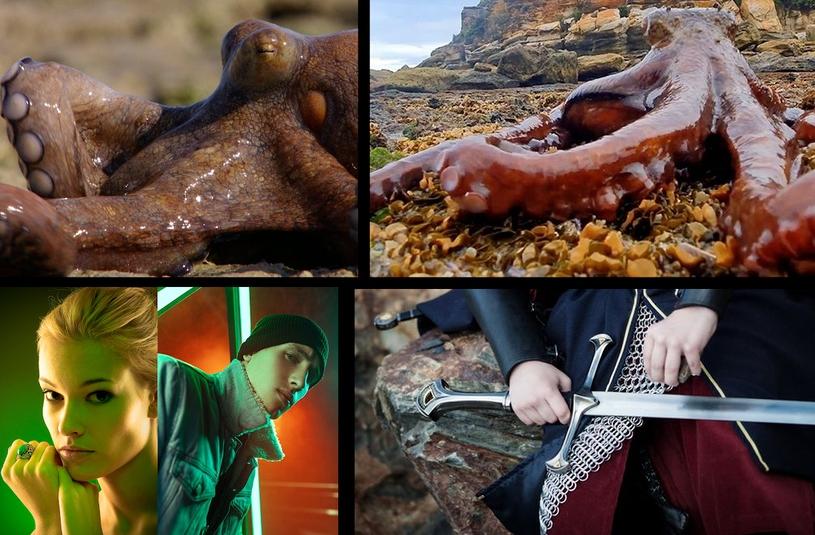
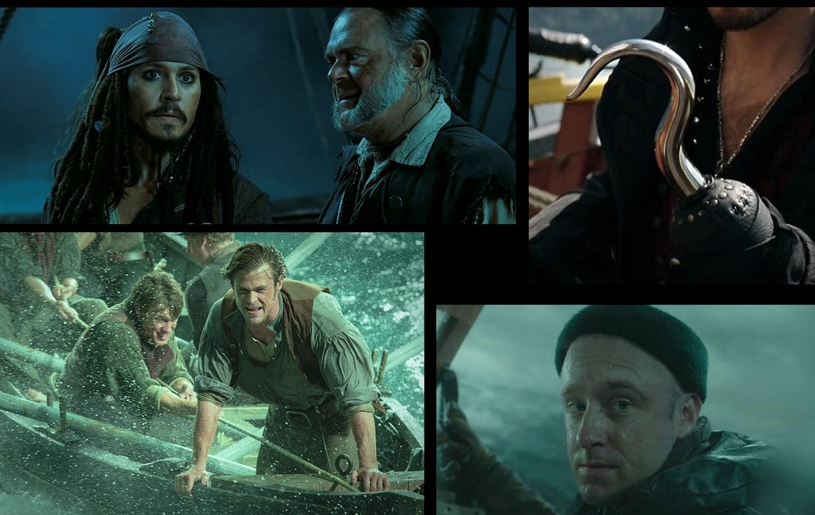
The purpose of the mood board is not to be used as a source to copy from, but to study how the materials behave and what they look like under different lighting. If you have enough time, you could even go as far as creating several quick studies from the reference materials to understand how things work in practice. This also applies to poses, angles, outfits etc. Over time, your visual library will grow and you will have an easier time drawing things “from your head”.
The author of this work is trying to work with a composition containing multiple characters and is looking for a solution within a closely matching color scheme. It is not an easy task to accomplish. To improve your skills you should continue to work on filling in the gaps in your knowledge. Go over all the details of the drawing and study them. You can also take some time to go back and look at the works of the masters to see how they handled composition, color and tone. Do some black and white studies to improve your understanding of tone and contrast. Analyze the properties of different materials in a variety of environments, study anatomy, volume of folds etc.
Stay tuned for more feedbacks on test assignments!
Email: info@sunstrikestudios.com
Kallipoleos 3, office 102, 1055 Nicosia, Cyprus
Sun Strike Gaming Ltd.
Tell us about your project. We will get in touch shortly to discuss in more detail. You can also email us at info@sunstrikestudios.com
© «SunStrike Studios» 2016-2026
Privacy Policy
Last updated: November 15, 2023
1. Who we are
1.1. We are Sun Strike Gaming Ltd located at Kallipoleos 3, office 102, 1055 Nicosia, Cyprus, working under the brand "Sunstrike Studios".
1.2. This Privacy Policy sets out how we collect and use your personal information when you use the mobile, online and downloadable products and services ("Services") offered by Sun Strike Gaming Ltd and its subsidiaries at https://sunstrikestudios.com/ and the choices available to you in connection with our use of your personal information (the Privacy Policy).This Privacy Policy should be read alongside, and in addition to, our terms and conditions at https://sunstrikestudios.com/ (Terms). In case of any contradictions between this Privacy Policy and the Terms, this Privacy Policy will prevail.
2. This Privacy Policy
2.1. By making available the Services we, acting reasonably and in good faith, believe that you:(a) have all necessary rights to register on and use the Services;(b) provide true information about yourself to the extent necessary for use of the Services;(c) understand that by the posting your personal information you have manifestly made this information public, and this information may become available to other Site users and internet users, be copied and disseminated by them;(d) understand that some types of information transferred by you to other Service users cannot be deleted by you or us;(e) are aware of and accept this Privacy Policy.
2.2. We do not check the user information received from you, except where such check is necessary in order for us to fulfill our obligations to you.
2.3. This Privacy Policy applies only to the European Union-based users. If you are not a European Union-based user, please refer to the Privacy Policy applicable in the relevant jurisdiction.
3. Information we collect about you
3.1. In order to implement the agreement between you and us, and provide you with access to the use of the Services, we will improve, develop and implement new features to our Services, and enhance the available Services functionality. To achieve these objectives, and in compliance with applicable laws, we will collect, store, aggregate, organise, extract, compare, use, and supplement your data (hereinafter “processing”). We will also receive and pass this data, and our automatically processed analyses of this data to our affiliates and partners as set out in the table below and section 4 of this Privacy Policy.
3.2. We set out in more detail the information we collect when you use our Services, why we collect and process it and the legal bases below.
# | Information Collected | Purpose | Legal Basis |
|---|---|---|---|
1 | Data you provide for registering in the Services including your email and/or mobile phone number | We use this information in order to manage and administer the Services provided to you. We use this data to enable us to fulfill our obligations to you as part of the Services (e.g. in cases where you request restoration of your account). See section 8.3 of this Privacy Policy for more information. We also use this information in order to provide you with updates and information on our and selected third parties' products and services we think you may be interested in. | Legitimate interests Performance of our contract with you |
2 | Where necessary, a copy of your identity or another document containing your name, surname, photograph, number of the principal identity document of you or your representative, payment details and another additional data, with that you may provide us, including through our support service.We may take additional verification steps where we consider reasonable in order to verify your account. | We use this data in order to identify you, verify your account and prevent abuse and infringements of your or other persons' rights.For example, we use this information to verify your identity if you lose your credentials and wish to access your account with us. | Legitimate Interests |
3 | Additional data you provide on dedicated Services profile page via including your first and last name, nickname, gender, date of birth, avatar picture and language preferences. | We use this information in order to provide our Services to you, to manage and administer Services and as additional information to verify your account to prevent abuse and infringements of your or other persons' rights. We also use this information in order to provide you with updates and information on our and selected third parties' products and services we think you may be interested in.We use this information in order to tailor and improve the adverts that are presented on the Site and measure the effectiveness of these advertisements. | Legitimate interests Performance of our contract with you |
4 | Additional data received when you access the Services, including information regarding technical devices, technical interaction with the Service such as your IP-address, time of registration in the Service, device ids, country and language settings, device model and operating system used, your installed apps, type of browser, your Internet provider and/or phone network operator, network type, screen resolution, RAM size and your browsing behavior. | We use your data for internal review in order to constantly improve the content of our Services and web pages, optimizing your user experience, to understand any errors you may encounter when using the Services, to notify you of changes to the Services and to personalise the use of our Services.We use this information in order to tailor and improve the adverts that are presented on the Site and measure the effectiveness of these advertisements. | Legitimate Interests |
5 | Information that is automatically received at the time of access to the Services with the use of cookies. | Please see our cookies policy which sets out the types of cookies we use and what we use these cookies for. We use this information in order to tailor and improve the adverts that are presented on the Site and measure the effectiveness of these advertisements. | Consent |
6 | Information that is created by you while using the Services (including information that you post in any game forums and/or chat rooms). Depending on the place of posting (chat room or forum) this information can be available to some or all other users of our Services. | We use this information in order to manage and administer the Services including providing our services to you. | Legitimate interests, which inter alia, include the processing of manifestly made public by you data Performance of our contract with you |
7 | Information that is created by you while placing requests to our Services support. | We use this information in order to verify your identity and to fulfil your support request. We may also use this data in order to investigate any complaints on your behalf and to provide you with a more efficient service. | Legitimate interests Performance of our contract with you |
8 | Information that is received as the result of your behavioral actions when using the Services (including your game actions and achievements, badges). This information can be available to other users of our Services (e.g. on Leaderboards). | We use this information in order to manage and administer the Services including providing our Services to you. We may also use this data in order to tailor and improve the adverts that are presented to you to and measure the effectiveness of these advertisements. | Legitimate interests |
9 | Information that is received about you as the result of other users’ actions on the Services (in particular, information posted in chat rooms and forums by other users). | We use this information in order to manage and administer the Services including providing our Services to you. | Legitimate interests |
10 | Data collected via third parties, including your social network ids, application store ids, nickname, email and friends list, when you register in our Services via you social or application store accounts and/or connect your social account to our Services. | We use this information in order to manage and administer the Services provided to you. We use this information for certain social functions of our Services, such as to show you who of your friends play the same game as you. We also use this information in order to provide you with updates and information on our and selected third parties' products and services we think you may be interested in. | Legitimate interests Performance of our contract with you |
3.3. Our legitimate interests include (1) maintaining and administrating the Services; (2) providing the Services to you; (3) improving the content of the Services and web pages; (4) processing of the data that was manifestly made public by you; (5) ensuring your account is adequately protected; and (6) compliance with any contractual, legal or regulatory obligations under any applicable law.
3.4. As part of maintaining and administrating the Services we use the information to analyse user activity and ensure that rules and terms of use for the Services are not violated.
3.5. Your personal information may also be processed if it is required by a law enforcement or regulatory authority, body or agency or in the defence or exercise of legal claims.We will not delete personal information if it is relevant to an investigation or a dispute.It will continue to be stored until those issues are fully resolved and/or during the term that is required and/or permissible under applicable/relevant law.
3.6. You may withdraw your consent to sending you marketing information by amending your privacy settings of your account.
3.7. Please note, if you do not want us to process sensitive and special categories of data about you (including data relating to your health, racial or ethnic origin, political opinion, religious or philosophical beliefs, sex life, and your sexual orientation) you should take care not to post this information or share this data on the Site.Once you have provided this data it will be accessible by other site users and it becomes difficult for us to remove this data.
3.8. Please note, if you withdraw your consent to processing or you do not provide the data that we require in order to maintain and administer the Services, you may not be able to access the Services or register with the web pages.
3.9. If we intend to further process your data for any other purpose to those set out in this Privacy Policy, we shall provide you with details of this further purpose before we commence processing.
4. Data sharing
4.1. Your username can be available to all of the Service users. We take technical and organizational measures to ensure that your data is safe. Please note that by the posting your personal information you have manifestly made this information public, and this may become available to other Service users and internet users and be copied and/ or disseminated by such users. Once this data is transferred by you to other users you will not be able to delete this data.
4.2. Sometimes we may need to share your data with a third party in order to provide our Services to you or to administer the Services, for example if you choose to share your data across other social media platforms.
4.3. We may also share your data with our third party contractors and application developers provided these third parties assume confidentiality obligations regarding your personal data collected by your use of the applications they offer. The developers use the information provided to them in order to provide you with additional services. Data will only be shared with these developers with your consent. You can authorise developers to access your information via our products.
4.4. Our ad management and recommendation system is designed so that your information will not be shared directly with our third party advertisers. An advertiser or maker of a recommendation can only choose to target advertisements to groups of users falling within criteria such as age, gender or location, or to target communities according to type, e.g. cars or fashion. If you fall within one of the target groups you will receive an advert or recommendation.
4.5. An advertiser or maker of recommendations may also choose to upload a list of emails, phone numbers and identities to our systems so that we (but not the adviser or maker of recommendations) can check for user matches. They will see the number of matches but not the matches themselves.
4.6. If you participate in public tournaments we may have the obligation to disclose your personal information to tax authorities. We also may publish your data as part of the tournament score tables on our and third party websites.
4.7. Sun Strike Gaming Ltd or our selected third party partners with our permission, using their own ad servers, can show advertisements to you.
5. Privacy Settings
5.1. The Services may contain links to sites operated by third parties. We are not responsible for your data privacy when you access these links or engage with third party services and you should ensure you review the relevant third party's privacy statement which will govern your data privacy rights.
5.2. We bear no liability for the actions of third parties which, as the result of your use of the internet or the Services, obtain access to your information in accordance with the confidentiality level selected by you.
5.3. We bear no liability for the consequences of use of the information which, due to the Services nature, is available to any internet user. We ask you to take a responsible approach to the scope of their information posted on the Site.
6. International Transfers
6.1. We may transfer and maintain on our servers or databases some of your personal information outside the European Economic Area (EEA) including in Russia.
6.2. The countries to which we transfer your data may not have the same data protection laws as your jurisdiction. We take reasonable cyber security measures and/or put in place the Standard Contractual Clauses (e.g. Model Clauses, Data Processing Agreement/Addendum) to ensure your data is adequately protected.
7. Retention Periods
7.1. We will retain your personal information for as long as required to perform the purposes for which the data was collected depending on the legal basis for which that data was obtained and/or whether additional legal/regulatory obligations mandate that we retain your personal information during the term that is required and/or permissible under applicable/relevant law.
7.2. You may delete your personal data by removing the data from your account; alternatively, you can delete your account.
7.3. We may remove your account, or the information you post as provided by the Terms.
8. Your Rights
8.1. You have the following rights, in certain circumstances, in relation to your personal information:(a) Right to access your personal information.(b) Right to rectify your personal information: you can request that we update, block or delete your personal data, if the data is incomplete, outdated, incorrect, unlawfully received or no longer relevant for the purpose of processing.(c) Right to restrict the use of your personal information.(d) Right to request that your personal information is erased.(e) Right to object to processing of your personal information.(f) Right to data portability (in certain specific circumstances).(g) Right not to be subject to an automated decision.(h) Right to lodge a complaint with a supervisory authority.
8.2. You also have a right to independently remove personal information on your account and make changes and corrections to your information, provided that such changes and corrections contain up-to-date and true information. You can also view an overview of the information we hold about you.
8.3. If you would like to exercise these rights, please contact Support Service at support@sunstrikestudios.com or send your request to us, in writing to Kallipoleos 3, office 102, 1055 Nicosia, Cyprus. We will aim to respond to you within 30 days from receipt of request. We will need to verify your identity before we are able to disclose any personal data to you.
9. Security Measures
9.1. We take technical, organizational and legal measures, including, where suitable, encryption, to ensure that your personal data are protected from unauthorized or accidental access, deletion, modification, blocking, copying and dissemination.
9.2. Access to the Services is authorized using your login (e-mail address or mobile phone number) and password. You are responsible for keeping this information confidential. You should not share your credentials with third parties and we recommend you take measures to ensure this information is kept confidential.
9.3. If you forget your login details, you can request us to send you an SMS or email, which will contain a restoration code.
9.4. To reduce the probability of third parties gaining unauthorized access, if you login to your account from an unusual place or after several failed attempts to provide valid login details, we may block entry to your account. You will then need to contact Service support and provide certain additional information to verify your credentials and gain access to your account.
10. Changes to this Policy
10.1. From time to time, we may change and/or update this Privacy Policy. If this Privacy Policy changes in any way, we will post an updated version on this page. We will store the previous versions of this Privacy Policy in our documentation achieve. We recommend you regularly review this page to ensure that you are always aware of our information practices and any changes to such.
11. Contact Us
11.1. If you have any questions, please send your inquiries to Service support at support@sunstrikestudios.com or send your request to us, in writing to Kallipoleos 3, office 102, 1055 Nicosia, Cyprus. So we can deal with your enquiry effectively, please quote this Privacy Policy. We will aim to respond to you within 30 days from receipt of request.
11.2. All correspondence received by us from you (written or electronic inquiries) is classified as restricted-access information and may not be disclosed without your written consent. The personal data and other information about you may not be used without your consent for any purpose other than for response to the inquiry, except as expressly provided by law.
© Sun Strike Gaming Ltd . 2023
Email: info@sunstrikestudios.com
Kallipoleos 3, office 102, 1055 Nicosia, Cyprus
Sun Strike Gaming Ltd.
Tell us about your project. We will get in touch shortly to discuss in more detail. You can also email us at info@sunstrikestudios.com
«SunStrike Studios» © 2016-2026
Privacy Policy
Last updated: November 15, 2023
1. Who we are
1.1. We are Sun Strike Gaming Ltd located at Kallipoleos 3, office 102, 1055 Nicosia, Cyprus, working under the brand "Sunstrike Studios".
1.2. This Privacy Policy sets out how we collect and use your personal information when you use the mobile, online and downloadable products and services ("Services") offered by Sun Strike Gaming Ltd and its subsidiaries at https://sunstrikestudios.com/ and the choices available to you in connection with our use of your personal information (the Privacy Policy).This Privacy Policy should be read alongside, and in addition to, our terms and conditions at https://sunstrikestudios.com/ (Terms). In case of any contradictions between this Privacy Policy and the Terms, this Privacy Policy will prevail.
2. This Privacy Policy
2.1. By making available the Services we, acting reasonably and in good faith, believe that you:(a) have all necessary rights to register on and use the Services;(b) provide true information about yourself to the extent necessary for use of the Services;(c) understand that by the posting your personal information you have manifestly made this information public, and this information may become available to other Site users and internet users, be copied and disseminated by them;(d) understand that some types of information transferred by you to other Service users cannot be deleted by you or us;(e) are aware of and accept this Privacy Policy.
2.2. We do not check the user information received from you, except where such check is necessary in order for us to fulfill our obligations to you.
2.3. This Privacy Policy applies only to the European Union-based users. If you are not a European Union-based user, please refer to the Privacy Policy applicable in the relevant jurisdiction.
3. Information we collect about you
3.1. In order to implement the agreement between you and us, and provide you with access to the use of the Services, we will improve, develop and implement new features to our Services, and enhance the available Services functionality. To achieve these objectives, and in compliance with applicable laws, we will collect, store, aggregate, organise, extract, compare, use, and supplement your data (hereinafter “processing”). We will also receive and pass this data, and our automatically processed analyses of this data to our affiliates and partners as set out in the table below and section 4 of this Privacy Policy.
3.2. We set out in more detail the information we collect when you use our Services, why we collect and process it and the legal bases below.
# | Information Collected | Purpose | Legal Basis |
|---|---|---|---|
1 | Data you provide for registering in the Services including your email and/or mobile phone number | We use this information in order to manage and administer the Services provided to you. We use this data to enable us to fulfill our obligations to you as part of the Services (e.g. in cases where you request restoration of your account). See section 8.3 of this Privacy Policy for more information. We also use this information in order to provide you with updates and information on our and selected third parties' products and services we think you may be interested in. | Legitimate interests Performance of our contract with you |
2 | Where necessary, a copy of your identity or another document containing your name, surname, photograph, number of the principal identity document of you or your representative, payment details and another additional data, with that you may provide us, including through our support service.We may take additional verification steps where we consider reasonable in order to verify your account. | We use this data in order to identify you, verify your account and prevent abuse and infringements of your or other persons' rights.For example, we use this information to verify your identity if you lose your credentials and wish to access your account with us. | Legitimate Interests |
3 | Additional data you provide on dedicated Services profile page via including your first and last name, nickname, gender, date of birth, avatar picture and language preferences. | We use this information in order to provide our Services to you, to manage and administer Services and as additional information to verify your account to prevent abuse and infringements of your or other persons' rights. We also use this information in order to provide you with updates and information on our and selected third parties' products and services we think you may be interested in.We use this information in order to tailor and improve the adverts that are presented on the Site and measure the effectiveness of these advertisements. | Legitimate interests Performance of our contract with you |
4 | Additional data received when you access the Services, including information regarding technical devices, technical interaction with the Service such as your IP-address, time of registration in the Service, device ids, country and language settings, device model and operating system used, your installed apps, type of browser, your Internet provider and/or phone network operator, network type, screen resolution, RAM size and your browsing behavior. | We use your data for internal review in order to constantly improve the content of our Services and web pages, optimizing your user experience, to understand any errors you may encounter when using the Services, to notify you of changes to the Services and to personalise the use of our Services.We use this information in order to tailor and improve the adverts that are presented on the Site and measure the effectiveness of these advertisements. | Legitimate Interests |
5 | Information that is automatically received at the time of access to the Services with the use of cookies. | Please see our cookies policy which sets out the types of cookies we use and what we use these cookies for. We use this information in order to tailor and improve the adverts that are presented on the Site and measure the effectiveness of these advertisements. | Consent |
6 | Information that is created by you while using the Services (including information that you post in any game forums and/or chat rooms). Depending on the place of posting (chat room or forum) this information can be available to some or all other users of our Services. | We use this information in order to manage and administer the Services including providing our services to you. | Legitimate interests, which inter alia, include the processing of manifestly made public by you data Performance of our contract with you |
7 | Information that is created by you while placing requests to our Services support. | We use this information in order to verify your identity and to fulfil your support request. We may also use this data in order to investigate any complaints on your behalf and to provide you with a more efficient service. | Legitimate interests Performance of our contract with you |
8 | Information that is received as the result of your behavioral actions when using the Services (including your game actions and achievements, badges). This information can be available to other users of our Services (e.g. on Leaderboards). | We use this information in order to manage and administer the Services including providing our Services to you. We may also use this data in order to tailor and improve the adverts that are presented to you to and measure the effectiveness of these advertisements. | Legitimate interests |
9 | Information that is received about you as the result of other users’ actions on the Services (in particular, information posted in chat rooms and forums by other users). | We use this information in order to manage and administer the Services including providing our Services to you. | Legitimate interests |
10 | Data collected via third parties, including your social network ids, application store ids, nickname, email and friends list, when you register in our Services via you social or application store accounts and/or connect your social account to our Services. | We use this information in order to manage and administer the Services provided to you. We use this information for certain social functions of our Services, such as to show you who of your friends play the same game as you. We also use this information in order to provide you with updates and information on our and selected third parties' products and services we think you may be interested in. | Legitimate interests Performance of our contract with you |
3.3. Our legitimate interests include (1) maintaining and administrating the Services; (2) providing the Services to you; (3) improving the content of the Services and web pages; (4) processing of the data that was manifestly made public by you; (5) ensuring your account is adequately protected; and (6) compliance with any contractual, legal or regulatory obligations under any applicable law.
3.4. As part of maintaining and administrating the Services we use the information to analyse user activity and ensure that rules and terms of use for the Services are not violated.
3.5. Your personal information may also be processed if it is required by a law enforcement or regulatory authority, body or agency or in the defence or exercise of legal claims.We will not delete personal information if it is relevant to an investigation or a dispute.It will continue to be stored until those issues are fully resolved and/or during the term that is required and/or permissible under applicable/relevant law.
3.6. You may withdraw your consent to sending you marketing information by amending your privacy settings of your account.
3.7. Please note, if you do not want us to process sensitive and special categories of data about you (including data relating to your health, racial or ethnic origin, political opinion, religious or philosophical beliefs, sex life, and your sexual orientation) you should take care not to post this information or share this data on the Site.Once you have provided this data it will be accessible by other site users and it becomes difficult for us to remove this data.
3.8. Please note, if you withdraw your consent to processing or you do not provide the data that we require in order to maintain and administer the Services, you may not be able to access the Services or register with the web pages.
3.9. If we intend to further process your data for any other purpose to those set out in this Privacy Policy, we shall provide you with details of this further purpose before we commence processing.
4. Data sharing
4.1. Your username can be available to all of the Service users. We take technical and organizational measures to ensure that your data is safe. Please note that by the posting your personal information you have manifestly made this information public, and this may become available to other Service users and internet users and be copied and/ or disseminated by such users. Once this data is transferred by you to other users you will not be able to delete this data.
4.2. Sometimes we may need to share your data with a third party in order to provide our Services to you or to administer the Services, for example if you choose to share your data across other social media platforms.
4.3. We may also share your data with our third party contractors and application developers provided these third parties assume confidentiality obligations regarding your personal data collected by your use of the applications they offer. The developers use the information provided to them in order to provide you with additional services. Data will only be shared with these developers with your consent. You can authorise developers to access your information via our products.
4.4. Our ad management and recommendation system is designed so that your information will not be shared directly with our third party advertisers. An advertiser or maker of a recommendation can only choose to target advertisements to groups of users falling within criteria such as age, gender or location, or to target communities according to type, e.g. cars or fashion. If you fall within one of the target groups you will receive an advert or recommendation.
4.5. An advertiser or maker of recommendations may also choose to upload a list of emails, phone numbers and identities to our systems so that we (but not the adviser or maker of recommendations) can check for user matches. They will see the number of matches but not the matches themselves.
4.6. If you participate in public tournaments we may have the obligation to disclose your personal information to tax authorities. We also may publish your data as part of the tournament score tables on our and third party websites.
4.7. Sun Strike Gaming Ltd or our selected third party partners with our permission, using their own ad servers, can show advertisements to you.
5. Privacy Settings
5.1. The Services may contain links to sites operated by third parties. We are not responsible for your data privacy when you access these links or engage with third party services and you should ensure you review the relevant third party's privacy statement which will govern your data privacy rights.
5.2. We bear no liability for the actions of third parties which, as the result of your use of the internet or the Services, obtain access to your information in accordance with the confidentiality level selected by you.
5.3. We bear no liability for the consequences of use of the information which, due to the Services nature, is available to any internet user. We ask you to take a responsible approach to the scope of their information posted on the Site.
6. International Transfers
6.1. We may transfer and maintain on our servers or databases some of your personal information outside the European Economic Area (EEA) including in Russia.
6.2. The countries to which we transfer your data may not have the same data protection laws as your jurisdiction. We take reasonable cyber security measures and/or put in place the Standard Contractual Clauses (e.g. Model Clauses, Data Processing Agreement/Addendum) to ensure your data is adequately protected.
7. Retention Periods
7.1. We will retain your personal information for as long as required to perform the purposes for which the data was collected depending on the legal basis for which that data was obtained and/or whether additional legal/regulatory obligations mandate that we retain your personal information during the term that is required and/or permissible under applicable/relevant law.
7.2. You may delete your personal data by removing the data from your account; alternatively, you can delete your account.
7.3. We may remove your account, or the information you post as provided by the Terms.
8. Your Rights
8.1. You have the following rights, in certain circumstances, in relation to your personal information:(a) Right to access your personal information.(b) Right to rectify your personal information: you can request that we update, block or delete your personal data, if the data is incomplete, outdated, incorrect, unlawfully received or no longer relevant for the purpose of processing.(c) Right to restrict the use of your personal information.(d) Right to request that your personal information is erased.(e) Right to object to processing of your personal information.(f) Right to data portability (in certain specific circumstances).(g) Right not to be subject to an automated decision.(h) Right to lodge a complaint with a supervisory authority.
8.2. You also have a right to independently remove personal information on your account and make changes and corrections to your information, provided that such changes and corrections contain up-to-date and true information. You can also view an overview of the information we hold about you.
8.3. If you would like to exercise these rights, please contact Support Service at support@sunstrikestudios.com or send your request to us, in writing to Kallipoleos 3, office 102, 1055 Nicosia, Cyprus. We will aim to respond to you within 30 days from receipt of request. We will need to verify your identity before we are able to disclose any personal data to you.
9. Security Measures
9.1. We take technical, organizational and legal measures, including, where suitable, encryption, to ensure that your personal data are protected from unauthorized or accidental access, deletion, modification, blocking, copying and dissemination.
9.2. Access to the Services is authorized using your login (e-mail address or mobile phone number) and password. You are responsible for keeping this information confidential. You should not share your credentials with third parties and we recommend you take measures to ensure this information is kept confidential.
9.3. If you forget your login details, you can request us to send you an SMS or email, which will contain a restoration code.
9.4. To reduce the probability of third parties gaining unauthorized access, if you login to your account from an unusual place or after several failed attempts to provide valid login details, we may block entry to your account. You will then need to contact Service support and provide certain additional information to verify your credentials and gain access to your account.
10. Changes to this Policy
10.1. From time to time, we may change and/or update this Privacy Policy. If this Privacy Policy changes in any way, we will post an updated version on this page. We will store the previous versions of this Privacy Policy in our documentation achieve. We recommend you regularly review this page to ensure that you are always aware of our information practices and any changes to such.
11. Contact Us
11.1. If you have any questions, please send your inquiries to Service support at support@sunstrikestudios.com or send your request to us, in writing to Kallipoleos 3, office 102, 1055 Nicosia, Cyprus. So we can deal with your enquiry effectively, please quote this Privacy Policy. We will aim to respond to you within 30 days from receipt of request.
11.2. All correspondence received by us from you (written or electronic inquiries) is classified as restricted-access information and may not be disclosed without your written consent. The personal data and other information about you may not be used without your consent for any purpose other than for response to the inquiry, except as expressly provided by law.
© Sun Strike Gaming Ltd. 2023
Email: info@sunstrikestudios.com
Kallipoleos 3, office 102, 1055 Nicosia, Cyprus
Sun Strike Gaming Ltd.
Tell us about your project. We will get in touch shortly to discuss in more detail. You can also email us at info@sunstrikestudios.com
© «SunStrike Studios» 2016-2026
Privacy Policy
Last updated: November 15, 2023
1. Who we are
1.1. We are Sun Strike Gaming Ltd located at Kallipoleos 3, office 102, 1055 Nicosia, Cyprus, working under the brand "Sunstrike Studios".
1.2. This Privacy Policy sets out how we collect and use your personal information when you use the mobile, online and downloadable products and services ("Services") offered by Sun Strike Gaming Ltd and its subsidiaries at https://sunstrikestudios.com/ and the choices available to you in connection with our use of your personal information (the Privacy Policy).This Privacy Policy should be read alongside, and in addition to, our terms and conditions at https://sunstrikestudios.com/ (Terms). In case of any contradictions between this Privacy Policy and the Terms, this Privacy Policy will prevail.
2. This Privacy Policy
2.1. By making available the Services we, acting reasonably and in good faith, believe that you:(a) have all necessary rights to register on and use the Services;(b) provide true information about yourself to the extent necessary for use of the Services;(c) understand that by the posting your personal information you have manifestly made this information public, and this information may become available to other Site users and internet users, be copied and disseminated by them;(d) understand that some types of information transferred by you to other Service users cannot be deleted by you or us;(e) are aware of and accept this Privacy Policy.
2.2. We do not check the user information received from you, except where such check is necessary in order for us to fulfill our obligations to you.
2.3. This Privacy Policy applies only to the European Union-based users. If you are not a European Union-based user, please refer to the Privacy Policy applicable in the relevant jurisdiction.
3. Information we collect about you
3.1. In order to implement the agreement between you and us, and provide you with access to the use of the Services, we will improve, develop and implement new features to our Services, and enhance the available Services functionality. To achieve these objectives, and in compliance with applicable laws, we will collect, store, aggregate, organise, extract, compare, use, and supplement your data (hereinafter “processing”). We will also receive and pass this data, and our automatically processed analyses of this data to our affiliates and partners as set out in the table below and section 4 of this Privacy Policy.
3.2. We set out in more detail the information we collect when you use our Services, why we collect and process it and the legal bases below.
# | Information Collected | Purpose | Legal Basis |
|---|---|---|---|
1 | Data you provide for registering in the Services including your email and/or mobile phone number | We use this information in order to manage and administer the Services provided to you. We use this data to enable us to fulfill our obligations to you as part of the Services (e.g. in cases where you request restoration of your account). See section 8.3 of this Privacy Policy for more information. We also use this information in order to provide you with updates and information on our and selected third parties' products and services we think you may be interested in. | Legitimate interests Performance of our contract with you |
2 | Where necessary, a copy of your identity or another document containing your name, surname, photograph, number of the principal identity document of you or your representative, payment details and another additional data, with that you may provide us, including through our support service.We may take additional verification steps where we consider reasonable in order to verify your account. | We use this data in order to identify you, verify your account and prevent abuse and infringements of your or other persons' rights.For example, we use this information to verify your identity if you lose your credentials and wish to access your account with us. | Legitimate Interests |
3 | Additional data you provide on dedicated Services profile page via including your first and last name, nickname, gender, date of birth, avatar picture and language preferences. | We use this information in order to provide our Services to you, to manage and administer Services and as additional information to verify your account to prevent abuse and infringements of your or other persons' rights. We also use this information in order to provide you with updates and information on our and selected third parties' products and services we think you may be interested in.We use this information in order to tailor and improve the adverts that are presented on the Site and measure the effectiveness of these advertisements. | Legitimate interests Performance of our contract with you |
4 | Additional data received when you access the Services, including information regarding technical devices, technical interaction with the Service such as your IP-address, time of registration in the Service, device ids, country and language settings, device model and operating system used, your installed apps, type of browser, your Internet provider and/or phone network operator, network type, screen resolution, RAM size and your browsing behavior. | We use your data for internal review in order to constantly improve the content of our Services and web pages, optimizing your user experience, to understand any errors you may encounter when using the Services, to notify you of changes to the Services and to personalise the use of our Services.We use this information in order to tailor and improve the adverts that are presented on the Site and measure the effectiveness of these advertisements. | Legitimate Interests |
5 | Information that is automatically received at the time of access to the Services with the use of cookies. | Please see our cookies policy which sets out the types of cookies we use and what we use these cookies for. We use this information in order to tailor and improve the adverts that are presented on the Site and measure the effectiveness of these advertisements. | Consent |
6 | Information that is created by you while using the Services (including information that you post in any game forums and/or chat rooms). Depending on the place of posting (chat room or forum) this information can be available to some or all other users of our Services. | We use this information in order to manage and administer the Services including providing our services to you. | Legitimate interests, which inter alia, include the processing of manifestly made public by you data Performance of our contract with you |
7 | Information that is created by you while placing requests to our Services support. | We use this information in order to verify your identity and to fulfil your support request. We may also use this data in order to investigate any complaints on your behalf and to provide you with a more efficient service. | Legitimate interests Performance of our contract with you |
8 | Information that is received as the result of your behavioral actions when using the Services (including your game actions and achievements, badges). This information can be available to other users of our Services (e.g. on Leaderboards). | We use this information in order to manage and administer the Services including providing our Services to you. We may also use this data in order to tailor and improve the adverts that are presented to you to and measure the effectiveness of these advertisements. | Legitimate interests |
9 | Information that is received about you as the result of other users’ actions on the Services (in particular, information posted in chat rooms and forums by other users). | We use this information in order to manage and administer the Services including providing our Services to you. | Legitimate interests |
10 | Data collected via third parties, including your social network ids, application store ids, nickname, email and friends list, when you register in our Services via you social or application store accounts and/or connect your social account to our Services. | We use this information in order to manage and administer the Services provided to you. We use this information for certain social functions of our Services, such as to show you who of your friends play the same game as you. We also use this information in order to provide you with updates and information on our and selected third parties' products and services we think you may be interested in. | Legitimate interests Performance of our contract with you |
3.3. Our legitimate interests include (1) maintaining and administrating the Services; (2) providing the Services to you; (3) improving the content of the Services and web pages; (4) processing of the data that was manifestly made public by you; (5) ensuring your account is adequately protected; and (6) compliance with any contractual, legal or regulatory obligations under any applicable law.
3.4. As part of maintaining and administrating the Services we use the information to analyse user activity and ensure that rules and terms of use for the Services are not violated.
3.5. Your personal information may also be processed if it is required by a law enforcement or regulatory authority, body or agency or in the defence or exercise of legal claims.We will not delete personal information if it is relevant to an investigation or a dispute.It will continue to be stored until those issues are fully resolved and/or during the term that is required and/or permissible under applicable/relevant law.
3.6. You may withdraw your consent to sending you marketing information by amending your privacy settings of your account.
3.7. Please note, if you do not want us to process sensitive and special categories of data about you (including data relating to your health, racial or ethnic origin, political opinion, religious or philosophical beliefs, sex life, and your sexual orientation) you should take care not to post this information or share this data on the Site.Once you have provided this data it will be accessible by other site users and it becomes difficult for us to remove this data.
3.8. Please note, if you withdraw your consent to processing or you do not provide the data that we require in order to maintain and administer the Services, you may not be able to access the Services or register with the web pages.
3.9. If we intend to further process your data for any other purpose to those set out in this Privacy Policy, we shall provide you with details of this further purpose before we commence processing.
4. Data sharing
4.1. Your username can be available to all of the Service users. We take technical and organizational measures to ensure that your data is safe. Please note that by the posting your personal information you have manifestly made this information public, and this may become available to other Service users and internet users and be copied and/ or disseminated by such users. Once this data is transferred by you to other users you will not be able to delete this data.
4.2. Sometimes we may need to share your data with a third party in order to provide our Services to you or to administer the Services, for example if you choose to share your data across other social media platforms.
4.3. We may also share your data with our third party contractors and application developers provided these third parties assume confidentiality obligations regarding your personal data collected by your use of the applications they offer. The developers use the information provided to them in order to provide you with additional services. Data will only be shared with these developers with your consent. You can authorise developers to access your information via our products.
4.4. Our ad management and recommendation system is designed so that your information will not be shared directly with our third party advertisers. An advertiser or maker of a recommendation can only choose to target advertisements to groups of users falling within criteria such as age, gender or location, or to target communities according to type, e.g. cars or fashion. If you fall within one of the target groups you will receive an advert or recommendation.
4.5. An advertiser or maker of recommendations may also choose to upload a list of emails, phone numbers and identities to our systems so that we (but not the adviser or maker of recommendations) can check for user matches. They will see the number of matches but not the matches themselves.
4.6. If you participate in public tournaments we may have the obligation to disclose your personal information to tax authorities. We also may publish your data as part of the tournament score tables on our and third party websites.
4.7. Sun Strike Gaming Ltd or our selected third party partners with our permission, using their own ad servers, can show advertisements to you.
5. Privacy Settings
5.1. The Services may contain links to sites operated by third parties. We are not responsible for your data privacy when you access these links or engage with third party services and you should ensure you review the relevant third party's privacy statement which will govern your data privacy rights.
5.2. We bear no liability for the actions of third parties which, as the result of your use of the internet or the Services, obtain access to your information in accordance with the confidentiality level selected by you.
5.3. We bear no liability for the consequences of use of the information which, due to the Services nature, is available to any internet user. We ask you to take a responsible approach to the scope of their information posted on the Site.
6. International Transfers
6.1. We may transfer and maintain on our servers or databases some of your personal information outside the European Economic Area (EEA) including in Russia.
6.2. The countries to which we transfer your data may not have the same data protection laws as your jurisdiction. We take reasonable cyber security measures and/or put in place the Standard Contractual Clauses (e.g. Model Clauses, Data Processing Agreement/Addendum) to ensure your data is adequately protected.
7. Retention Periods
7.1. We will retain your personal information for as long as required to perform the purposes for which the data was collected depending on the legal basis for which that data was obtained and/or whether additional legal/regulatory obligations mandate that we retain your personal information during the term that is required and/or permissible under applicable/relevant law.
7.2. You may delete your personal data by removing the data from your account; alternatively, you can delete your account.
7.3. We may remove your account, or the information you post as provided by the Terms.
8. Your Rights
8.1. You have the following rights, in certain circumstances, in relation to your personal information:(a) Right to access your personal information.(b) Right to rectify your personal information: you can request that we update, block or delete your personal data, if the data is incomplete, outdated, incorrect, unlawfully received or no longer relevant for the purpose of processing.(c) Right to restrict the use of your personal information.(d) Right to request that your personal information is erased.(e) Right to object to processing of your personal information.(f) Right to data portability (in certain specific circumstances).(g) Right not to be subject to an automated decision.(h) Right to lodge a complaint with a supervisory authority.
8.2. You also have a right to independently remove personal information on your account and make changes and corrections to your information, provided that such changes and corrections contain up-to-date and true information. You can also view an overview of the information we hold about you.
8.3. If you would like to exercise these rights, please contact Support Service at support@sunstrikestudios.com or send your request to us, in writing to Kallipoleos 3, office 102, 1055 Nicosia, Cyprus. We will aim to respond to you within 30 days from receipt of request. We will need to verify your identity before we are able to disclose any personal data to you.
9. Security Measures
9.1. We take technical, organizational and legal measures, including, where suitable, encryption, to ensure that your personal data are protected from unauthorized or accidental access, deletion, modification, blocking, copying and dissemination.
9.2. Access to the Services is authorized using your login (e-mail address or mobile phone number) and password. You are responsible for keeping this information confidential. You should not share your credentials with third parties and we recommend you take measures to ensure this information is kept confidential.
9.3. If you forget your login details, you can request us to send you an SMS or email, which will contain a restoration code.
9.4. To reduce the probability of third parties gaining unauthorized access, if you login to your account from an unusual place or after several failed attempts to provide valid login details, we may block entry to your account. You will then need to contact Service support and provide certain additional information to verify your credentials and gain access to your account.
10. Changes to this Policy
10.1. From time to time, we may change and/or update this Privacy Policy. If this Privacy Policy changes in any way, we will post an updated version on this page. We will store the previous versions of this Privacy Policy in our documentation achieve. We recommend you regularly review this page to ensure that you are always aware of our information practices and any changes to such.
11. Contact Us
11.1. If you have any questions, please send your inquiries to Service support at support@sunstrikestudios.com or send your request to us, in writing to Kallipoleos 3, office 102, 1055 Nicosia, Cyprus. So we can deal with your enquiry effectively, please quote this Privacy Policy. We will aim to respond to you within 30 days from receipt of request.
11.2. All correspondence received by us from you (written or electronic inquiries) is classified as restricted-access information and may not be disclosed without your written consent. The personal data and other information about you may not be used without your consent for any purpose other than for response to the inquiry, except as expressly provided by law.
© Sun Strike Gaming Ltd . 2023
Privacy Policy
Last updated: November 15, 2023
1. Who we are
1.1. We are Sun Strike Gaming Ltd located at Kallipoleos 3, office 102, 1055 Nicosia, Cyprus, working under the brand "Sunstrike Studios".
1.2. This Privacy Policy sets out how we collect and use your personal information when you use the mobile, online and downloadable products and services ("Services") offered by Sun Strike Gaming Ltd and its subsidiaries at https://sunstrikestudios.com/ and the choices available to you in connection with our use of your personal information (the Privacy Policy).This Privacy Policy should be read alongside, and in addition to, our terms and conditions at https://sunstrikestudios.com/ (Terms). In case of any contradictions between this Privacy Policy and the Terms, this Privacy Policy will prevail.
2. This Privacy Policy
2.1. By making available the Services we, acting reasonably and in good faith, believe that you:(a) have all necessary rights to register on and use the Services;(b) provide true information about yourself to the extent necessary for use of the Services;(c) understand that by the posting your personal information you have manifestly made this information public, and this information may become available to other Site users and internet users, be copied and disseminated by them;(d) understand that some types of information transferred by you to other Service users cannot be deleted by you or us;(e) are aware of and accept this Privacy Policy.
2.2. We do not check the user information received from you, except where such check is necessary in order for us to fulfill our obligations to you.
2.3. This Privacy Policy applies only to the European Union-based users. If you are not a European Union-based user, please refer to the Privacy Policy applicable in the relevant jurisdiction.
3. Information we collect about you
3.1. In order to implement the agreement between you and us, and provide you with access to the use of the Services, we will improve, develop and implement new features to our Services, and enhance the available Services functionality. To achieve these objectives, and in compliance with applicable laws, we will collect, store, aggregate, organise, extract, compare, use, and supplement your data (hereinafter “processing”). We will also receive and pass this data, and our automatically processed analyses of this data to our affiliates and partners as set out in the table below and section 4 of this Privacy Policy.
3.2. We set out in more detail the information we collect when you use our Services, why we collect and process it and the legal bases below.
# | Information Collected | Purpose | Legal Basis |
|---|---|---|---|
1 | Data you provide for registering in the Services including your email and/or mobile phone number | We use this information in order to manage and administer the Services provided to you. We use this data to enable us to fulfill our obligations to you as part of the Services (e.g. in cases where you request restoration of your account). See section 8.3 of this Privacy Policy for more information. We also use this information in order to provide you with updates and information on our and selected third parties' products and services we think you may be interested in. | Legitimate interests Performance of our contract with you |
2 | Where necessary, a copy of your identity or another document containing your name, surname, photograph, number of the principal identity document of you or your representative, payment details and another additional data, with that you may provide us, including through our support service.We may take additional verification steps where we consider reasonable in order to verify your account. | We use this data in order to identify you, verify your account and prevent abuse and infringements of your or other persons' rights.For example, we use this information to verify your identity if you lose your credentials and wish to access your account with us. | Legitimate Interests |
3 | Additional data you provide on dedicated Services profile page via including your first and last name, nickname, gender, date of birth, avatar picture and language preferences. | We use this information in order to provide our Services to you, to manage and administer Services and as additional information to verify your account to prevent abuse and infringements of your or other persons' rights. We also use this information in order to provide you with updates and information on our and selected third parties' products and services we think you may be interested in.We use this information in order to tailor and improve the adverts that are presented on the Site and measure the effectiveness of these advertisements. | Legitimate interests Performance of our contract with you |
4 | Additional data received when you access the Services, including information regarding technical devices, technical interaction with the Service such as your IP-address, time of registration in the Service, device ids, country and language settings, device model and operating system used, your installed apps, type of browser, your Internet provider and/or phone network operator, network type, screen resolution, RAM size and your browsing behavior. | We use your data for internal review in order to constantly improve the content of our Services and web pages, optimizing your user experience, to understand any errors you may encounter when using the Services, to notify you of changes to the Services and to personalise the use of our Services.We use this information in order to tailor and improve the adverts that are presented on the Site and measure the effectiveness of these advertisements. | Legitimate Interests |
5 | Information that is automatically received at the time of access to the Services with the use of cookies. | Please see our cookies policy which sets out the types of cookies we use and what we use these cookies for. We use this information in order to tailor and improve the adverts that are presented on the Site and measure the effectiveness of these advertisements. | Consent |
6 | Information that is created by you while using the Services (including information that you post in any game forums and/or chat rooms). Depending on the place of posting (chat room or forum) this information can be available to some or all other users of our Services. | We use this information in order to manage and administer the Services including providing our services to you. | Legitimate interests, which inter alia, include the processing of manifestly made public by you data Performance of our contract with you |
7 | Information that is created by you while placing requests to our Services support. | We use this information in order to verify your identity and to fulfil your support request. We may also use this data in order to investigate any complaints on your behalf and to provide you with a more efficient service. | Legitimate interests Performance of our contract with you |
8 | Information that is received as the result of your behavioral actions when using the Services (including your game actions and achievements, badges). This information can be available to other users of our Services (e.g. on Leaderboards). | We use this information in order to manage and administer the Services including providing our Services to you. We may also use this data in order to tailor and improve the adverts that are presented to you to and measure the effectiveness of these advertisements. | Legitimate interests |
9 | Information that is received about you as the result of other users’ actions on the Services (in particular, information posted in chat rooms and forums by other users). | We use this information in order to manage and administer the Services including providing our Services to you. | Legitimate interests |
10 | Data collected via third parties, including your social network ids, application store ids, nickname, email and friends list, when you register in our Services via you social or application store accounts and/or connect your social account to our Services. | We use this information in order to manage and administer the Services provided to you. We use this information for certain social functions of our Services, such as to show you who of your friends play the same game as you. We also use this information in order to provide you with updates and information on our and selected third parties' products and services we think you may be interested in. | Legitimate interests Performance of our contract with you |
3.3. Our legitimate interests include (1) maintaining and administrating the Services; (2) providing the Services to you; (3) improving the content of the Services and web pages; (4) processing of the data that was manifestly made public by you; (5) ensuring your account is adequately protected; and (6) compliance with any contractual, legal or regulatory obligations under any applicable law.
3.4. As part of maintaining and administrating the Services we use the information to analyse user activity and ensure that rules and terms of use for the Services are not violated.
3.5. Your personal information may also be processed if it is required by a law enforcement or regulatory authority, body or agency or in the defence or exercise of legal claims.We will not delete personal information if it is relevant to an investigation or a dispute.It will continue to be stored until those issues are fully resolved and/or during the term that is required and/or permissible under applicable/relevant law.
3.6. You may withdraw your consent to sending you marketing information by amending your privacy settings of your account.
3.7. Please note, if you do not want us to process sensitive and special categories of data about you (including data relating to your health, racial or ethnic origin, political opinion, religious or philosophical beliefs, sex life, and your sexual orientation) you should take care not to post this information or share this data on the Site.Once you have provided this data it will be accessible by other site users and it becomes difficult for us to remove this data.
3.8. Please note, if you withdraw your consent to processing or you do not provide the data that we require in order to maintain and administer the Services, you may not be able to access the Services or register with the web pages.
3.9. If we intend to further process your data for any other purpose to those set out in this Privacy Policy, we shall provide you with details of this further purpose before we commence processing.
4. Data sharing
4.1. Your username can be available to all of the Service users. We take technical and organizational measures to ensure that your data is safe. Please note that by the posting your personal information you have manifestly made this information public, and this may become available to other Service users and internet users and be copied and/ or disseminated by such users. Once this data is transferred by you to other users you will not be able to delete this data.
4.2. Sometimes we may need to share your data with a third party in order to provide our Services to you or to administer the Services, for example if you choose to share your data across other social media platforms.
4.3. We may also share your data with our third party contractors and application developers provided these third parties assume confidentiality obligations regarding your personal data collected by your use of the applications they offer. The developers use the information provided to them in order to provide you with additional services. Data will only be shared with these developers with your consent. You can authorise developers to access your information via our products.
4.4. Our ad management and recommendation system is designed so that your information will not be shared directly with our third party advertisers. An advertiser or maker of a recommendation can only choose to target advertisements to groups of users falling within criteria such as age, gender or location, or to target communities according to type, e.g. cars or fashion. If you fall within one of the target groups you will receive an advert or recommendation.
4.5. An advertiser or maker of recommendations may also choose to upload a list of emails, phone numbers and identities to our systems so that we (but not the adviser or maker of recommendations) can check for user matches. They will see the number of matches but not the matches themselves.
4.6. If you participate in public tournaments we may have the obligation to disclose your personal information to tax authorities. We also may publish your data as part of the tournament score tables on our and third party websites.
4.7. Sun Strike Studios (Cyprus) Ltd or our selected third party partners with our permission, using their own ad servers, can show advertisements to you.
5. Privacy Settings
5.1. The Services may contain links to sites operated by third parties. We are not responsible for your data privacy when you access these links or engage with third party services and you should ensure you review the relevant third party's privacy statement which will govern your data privacy rights.
5.2. We bear no liability for the actions of third parties which, as the result of your use of the internet or the Services, obtain access to your information in accordance with the confidentiality level selected by you.
5.3. We bear no liability for the consequences of use of the information which, due to the Services nature, is available to any internet user. We ask you to take a responsible approach to the scope of their information posted on the Site.
6. International Transfers
6.1. We may transfer and maintain on our servers or databases some of your personal information outside the European Economic Area (EEA) including in Russia.
6.2. The countries to which we transfer your data may not have the same data protection laws as your jurisdiction. We take reasonable cyber security measures and/or put in place the Standard Contractual Clauses (e.g. Model Clauses, Data Processing Agreement/Addendum) to ensure your data is adequately protected.
7. Retention Periods
7.1. We will retain your personal information for as long as required to perform the purposes for which the data was collected depending on the legal basis for which that data was obtained and/or whether additional legal/regulatory obligations mandate that we retain your personal information during the term that is required and/or permissible under applicable/relevant law.
7.2. You may delete your personal data by removing the data from your account; alternatively, you can delete your account.
7.3. We may remove your account, or the information you post as provided by the Terms.
8. Your Rights
8.1. You have the following rights, in certain circumstances, in relation to your personal information:(a) Right to access your personal information.(b) Right to rectify your personal information: you can request that we update, block or delete your personal data, if the data is incomplete, outdated, incorrect, unlawfully received or no longer relevant for the purpose of processing.(c) Right to restrict the use of your personal information.(d) Right to request that your personal information is erased.(e) Right to object to processing of your personal information.(f) Right to data portability (in certain specific circumstances).(g) Right not to be subject to an automated decision.(h) Right to lodge a complaint with a supervisory authority.
8.2. You also have a right to independently remove personal information on your account and make changes and corrections to your information, provided that such changes and corrections contain up-to-date and true information. You can also view an overview of the information we hold about you.
8.3. If you would like to exercise these rights, please contact Support Service at support@sunstrikestudios.com or send your request to us, in writing to Kallipoleos 3, office 102, 1055 Nicosia, Cyprus. We will aim to respond to you within 30 days from receipt of request. We will need to verify your identity before we are able to disclose any personal data to you.
9. Security Measures
9.1. We take technical, organizational and legal measures, including, where suitable, encryption, to ensure that your personal data are protected from unauthorized or accidental access, deletion, modification, blocking, copying and dissemination.
9.2. Access to the Services is authorized using your login (e-mail address or mobile phone number) and password. You are responsible for keeping this information confidential. You should not share your credentials with third parties and we recommend you take measures to ensure this information is kept confidential.
9.3. If you forget your login details, you can request us to send you an SMS or email, which will contain a restoration code.
9.4. To reduce the probability of third parties gaining unauthorized access, if you login to your account from an unusual place or after several failed attempts to provide valid login details, we may block entry to your account. You will then need to contact Service support and provide certain additional information to verify your credentials and gain access to your account.
10. Changes to this Policy
10.1. From time to time, we may change and/or update this Privacy Policy. If this Privacy Policy changes in any way, we will post an updated version on this page. We will store the previous versions of this Privacy Policy in our documentation achieve. We recommend you regularly review this page to ensure that you are always aware of our information practices and any changes to such.
11. Contact Us
11.1. If you have any questions, please send your inquiries to Service support at support@sunstrikestudios.com or send your request to us, in writing to Kallipoleos 3, office 102, 1055 Nicosia, Cyprus. So we can deal with your enquiry effectively, please quote this Privacy Policy. We will aim to respond to you within 30 days from receipt of request.
11.2. All correspondence received by us from you (written or electronic inquiries) is classified as restricted-access information and may not be disclosed without your written consent. The personal data and other information about you may not be used without your consent for any purpose other than for response to the inquiry, except as expressly provided by law.
© Sun Strike Gaming Ltd . 2023
Данный сайт использует Cookie
Редактируемый текст



